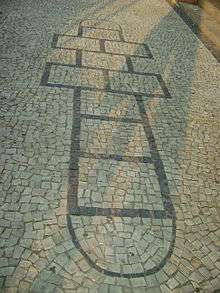List of traditional children's games
This is a list of games that used to be played by children quite some time ago, some of which are still being played now. Traditional children's games do not include commercial products such as board games, but do include games which require props such as hopscotch or marbles. "'Traditional' games", have, "not only failed to disappear, but have also evolved over time into new versions."[1]
Traditional children's games are defined, "as those that are played informally with minimal equipment, that children learn by example from other children, and that can be played without reference to written rules. These games are usually played by children between the ages of 7 and 12, with some latitude on both ends of the age range."[2] "Children's traditional games (also called folk games) are those that are passed from child to child, generation to generation, informally by word of mouth," and most children's games include at least two of the following six features in different proportion: physical skill, strategy, chance, repetition of patterns, creativity, and vertigo.[3]
A
B
- Ball games[4][5]
- Ball tag
- Blind man's buff[5]
- British bulldogs
- Button, button, who's got the button?
- Bloody Knuckles
- Buck buck (see also High Cockalorum)
C
- Cat's cradle
- Catch
- Chain tag
- Chinese whispers (telephone[4])
- Chopsticks
- Clapping games[4][5]
- Conkers
- Continuous cricket
- Cops and robbers
- Counting out[4][5]
- Crack the Whip
D
F
G
H
- Hand Ball
- Hand games[4]
- Here Comes an Old Soldier from Botany Bay
- Hide-and-go-seek[4][5]
- Hi ho cherry-o
- High Cockalorum (see also Buck buck)
- Hoop rolling
- Hopscotch[4][5]
- Hot lava
- Hot potato
- House[6]
- Hunt the Thimble[4]
- Hungry Hungry Hippos
I
J
K
L
M
N
O
P
- Paddle ball
- Paper football
- Patty cake
- Peekaboo
- Pencil fighting
- Pick-up sticks
- Pie
- Pitching pennies
- Poison
- Poohsticks
Q
R
S
- Sardines[11]
- Seven Up
- Sharks and minnows
- Silent ball
- Simon says[6]
- Singing games
- Skipping rope
- Stone skipping
- Skully
- Sleeping lions
- Spud
- Statues (red light, green light; Grandmother's Footsteps)
- Stickball
- Stuck in the mud
- Stoop ball
- String games[5] (cat's cradle)
T
W
References
- ↑ Lindon, Jennie (2001). Understanding Children's Play, p.83. Nelson Thornes. ISBN 9780748739707.
- ↑ Sierra, Judy and Kaminski, Robert (1995). Children's Traditional Games, p.xii. Oryx. ISBN 0897749677.
- ↑ Sierra and Kaminski (1995), p.3.
- 1 2 3 4 5 6 7 8 9 10 11 12 13 Gryski, Camilla (1998). Let's Play: Traditional Games of Childhood, p.5. Kids Can. ISBN 1550744976.
- 1 2 3 4 5 6 7 8 9 10 11 12 13 14 Sierra and Kaminski (1995), p.v-vi.
- 1 2 3 Schaefer, Charles E.; Reid, Steven E.; eds. (2004). Game Play: Therapeutic Use of Childhood Games, p.10. John Wiley & Sons. ISBN 9780471437338.
- 1 2 Gryski (1998), p.16.
- ↑ "Leapfrog", Merriam-Webster.com. Accessed June 27, 2015.
- ↑ Newell, W. W. (2010). Games and Songs of American Children, p.189. Nabu Press. ISBN 978-1-145-39322-6.
- ↑ Gryski (1998), p.26.
- ↑ Gryski (1998), p.15.
- 1 2 3 Gryski (1998), p.10-11.
